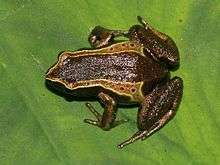Cardioglossa oreas
Cardioglossa oreas (common name: Mount Okou long-fingered frog[1][2][3]) is a species of frog in the family Arthroleptidae.[1][2][4] It is endemic to Cameroon and known from the Western High Plateau between Mount Oku and the Bamboutos Mountains.[1] Records from Mount Manengouba refer to Cardioglossa manengouba.[1]
| Cardioglossa oreas | |
|---|---|
 | |
| Scientific classification | |
| Kingdom: | Animalia |
| Phylum: | Chordata |
| Class: | Amphibia |
| Order: | Anura |
| Family: | Arthroleptidae |
| Genus: | Cardioglossa |
| Species: | C. oreas |
| Binomial name | |
| Cardioglossa oreas Amiet, 1972 | |
Description
Males measure 23–23 mm (0.9–0.9 in) and females 27–30 mm (1.1–1.2 in) in snout–vent length.[5] Unusually for the genus Cardioglossa, the third finger in males is not elongated. It is nevertheless sexually dimorphic in that males have spines in the fingers whereas females do not.[6] The tympanum is small and inconspicuous, another unusual character within Cardioglossa.[7] Furthermore, the characteristic dorsal markings and the white line running under the tympanum are absent.[5] Despite these unusual morphological characters, genetic data nest C. oreas well within the genus Cardioglossa.[6][8]
Habitat and conservation
Cardioglossa oreas occurs in montane forests, often in bamboo forests; it also occurs in degraded habitats containing trees. It is typically found in areas around fast-flowing streams, its breeding habitat. Its altitudinal range is 1,900–2,650 m (6,230–8,690 ft) above sea level.[1]
Cardioglossa oreas is common within its small range, but the distribution of this species is severely fragmented and its forest habitat is declining. It occurs in the Bafut-Ngemba Forest Reserve.[1]
References
- IUCN SSC Amphibian Specialist Group (2015). "Cardioglossa oreas". The IUCN Red List of Threatened Species. IUCN. 2015: e.T54407A16864715. doi:10.2305/IUCN.UK.2015-2.RLTS.T54407A16864715.en.
- Frost, Darrel R. (2018). "Cardioglossa oreas Amiet, 1972". Amphibian Species of the World: an Online Reference. Version 6.0. American Museum of Natural History. Retrieved 13 May 2018.
- "Mount Okou long-fingered frog". ARKive. Archived from the original on 2014-03-04. Retrieved 28 February 2013.
- "Cardioglossa oreas". Animal Diversity Web. Retrieved 28 February 2013.
- Hirschfeld, Mareike; Blackburn, David C.; Burger, Marius; Greenbaum, Eli; Zassi-Boulou, Ange-Ghislain & Rödel, Mark-Oliver (2015). "Two new species of long-fingered frogs of the genus Cardioglossa (Anura: Arthroleptidae) from Central African rainforests". African Journal of Herpetology. 64 (2): 81–102. doi:10.1080/21564574.2015.1052102.
- Blackburn, David C. (2009). "Diversity and evolution of male secondary sexual characters in African squeakers and long-fingered frogs". Biological Journal of the Linnean Society. 96 (3): 553–573. doi:10.1111/j.1095-8312.2008.01138.x.
- Blackburn, David C.; Kosuch, Joachim; Schmitz, Andreas; Burger, Marius; Wagner, Philipp; Gonwouo, L. Nono; Hillers, Annika & Rödel, Mark-Oliver (2008). "A new species of Cardioglossa (Anura: Artholeptidae) from the Upper Guinean forests of West Africa" (PDF). Copeia. 2008 (3): 603–612. doi:10.1643/CH-06-233.
- Blackburn, D. (2008). "Biogeography and evolution of body size and life history of African frogs: Phylogeny of squeakers (Arthroleptis) and long-fingered frogs (Cardioglossa) estimated from mitochondrial data". Molecular Phylogenetics and Evolution. 49 (3): 806–826. doi:10.1016/j.ympev.2008.08.015. PMID 18804169.
| Wikimedia Commons has media related to Cardioglossa oreas. |
